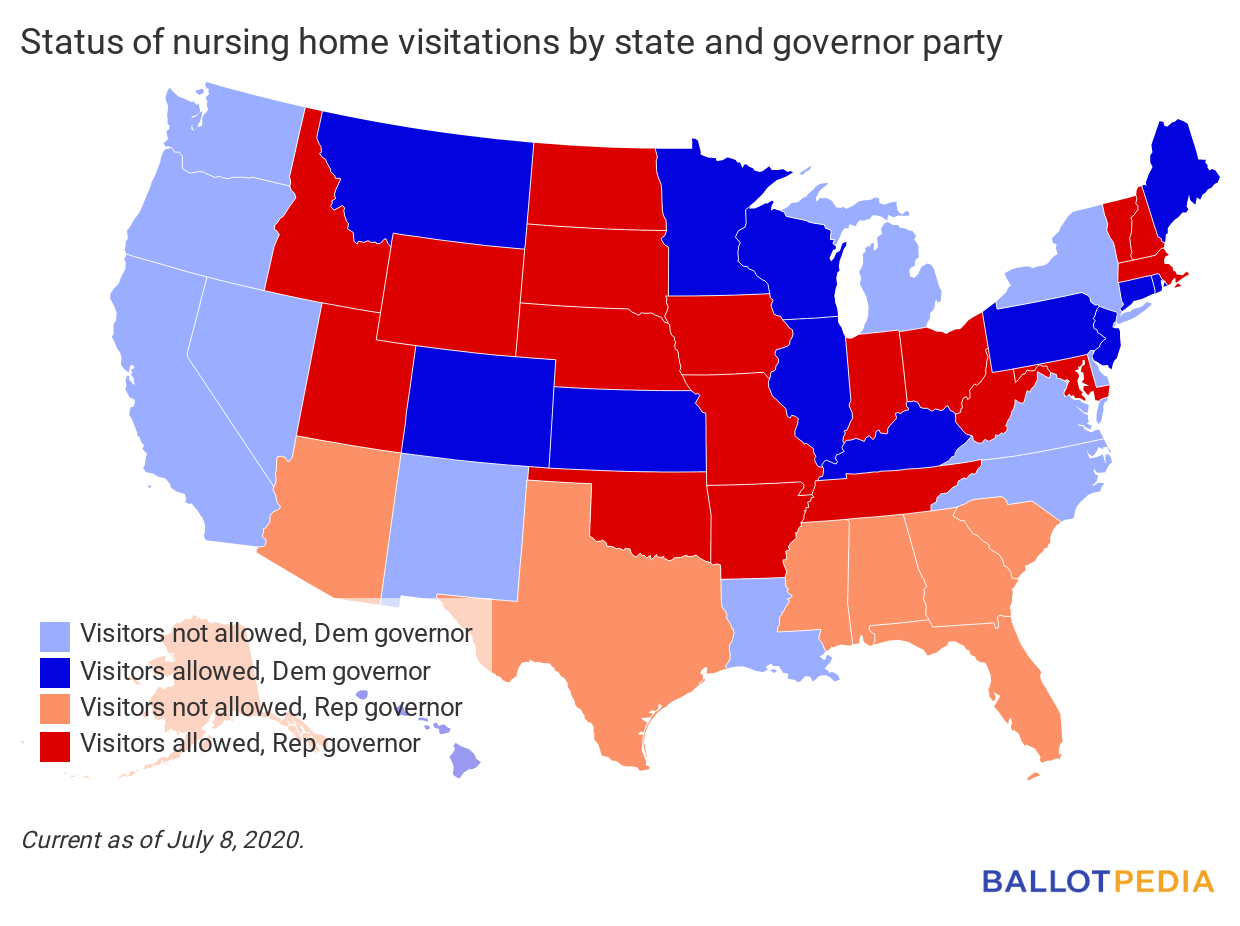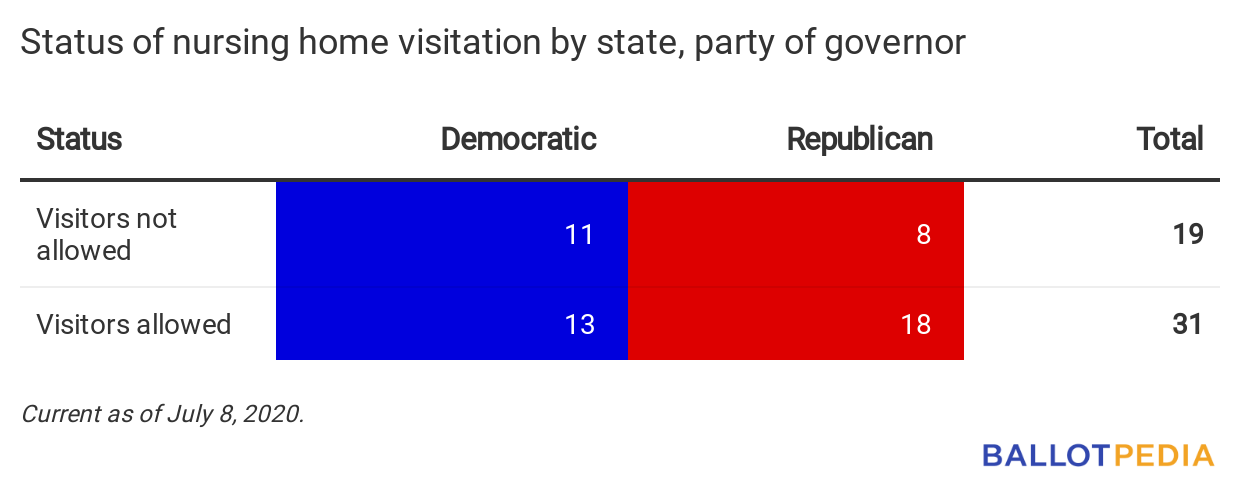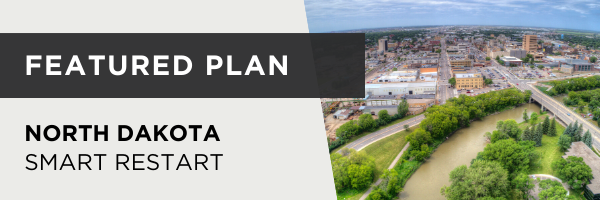Each day, we:
- Track the status of reopening in all 50 states.
- Compare the status of one industry or activity across the country.
- Provide in-depth summaries of the latest reopening plans.
- Give you the latest stories on other reopening plans and ideas.
Want to know what happened yesterday? Click here.
The next two days
What is reopening in the next two days?
July 9
- Maine (Democratic trifecta): One of Maine’s two casinos, Bangor’s Hollywood Casino, will reopen on July 9. The expected reopening comes after state officials and casino executives reached an agreement on capacity limits and other mitigation measures. Public Safety Commissioner Michael Sauschuck said the overall capacity limit for each casino will be 200 people, with no more than 50 people allowed in each of four zones into which the casinos will be divided. Face coverings will be required.
Since our last edition
What is open in each state? For a continually updated article on reopening status in all 50 states, click here. For our last edition, click here.
- New Jersey (Democratic trifecta): Gov. Phil Murphy (D) is signing an executive order on July 8 requiring individuals to wear face masks outdoors when social distancing is not possible.
- Ohio (Republican trifecta): The Director of the Ohio Department of Rehabilitation and Correction announced on July 7 that in-person visitations will resume at some prisons. To resume in-person visitations, facilities will need to develop a written plan and require staff, incarcerated adults, and visitors to wear masks at all times.
- Rhode Island (Democratic trifecta): The state is beginning to allow limited visits to long-term care and assisted living facilities on July 8. Before opening to visitors, facilities must develop visitation plans which must be approved by the Rhode Island Department of Health.
- Texas (Republican trifecta): Texas Education Commissioner Mike Morath released guidance for reopening schools in the fall on July 7. Parents will be able to choose between on-campus and distance learning options. Masks will be required in school buildings.
- Washington (Democratic trifecta): On July 7, Gov. Jay Inslee (D) announced that businesses are prohibited from serving customers in public settings who do not wear face coverings. Customers are likewise prohibited from entering businesses without a face covering. Inslee also modified Phase 2 and Phase 3 of the reopening plan to prohibit bars and taverns from offering bar-style seating and live music.
Update on stay-at-home orders
Forty-three states issued orders directing residents to stay home except for essential activities and the closure or curtailment of businesses each state deemed nonessential. Seven states did not.
As of July 8, stay-at-home orders have ended in 41 states. Nineteen of those states have Republican governors and 22 have Democratic governors (including Wisconsin, where the state supreme court invalidated the stay-at-home order).
California and New Mexico, both of which have a Democratic governor, are the only remaining states with an active stay-at-home order.
Tracking activities: Nursing home visits
All 50 states are reopening in some way. Here, we give the status of one industry or activity across the states. Today’s question: in which states may you visit someone in a nursing home? This does not include end-of-life or other emergency-related visits. Visits limited to family members only, or that are only allowed outdoors, are counted as “visitors allowed” in the chart and map below.
We last looked at nursing home visitation in the June 23rd edition of the newsletter. Since then, the following seven states have allowed visits to nursing homes: Arkansas, Colorado, Kentucky, Montana, New Hampshire, Pennsylvania, and Rhode Island.
 
|

This is an in-depth summary of one of the latest reopening plans. Click a state below to read a previous Featured Plan.
North Dakota Gov. Doug Burgum (R) announced protocols for the Smart Restart reopening plan on April 28. The plan has five stages: Critical Risk (red), High Risk (orange), Moderate Risk (yellow), Low Risk (green), and New Normal (blue). The state never operated under the Critical Risk phase, but the plan says reopenings can be reversed if the state does not contain the virus.
The plan took effect on May 1, allowing most businesses to reopen in the Moderate Risk phase. This included gyms, restaurants and bars for dine-in service, barbershops and salons, and bowling alleys. Gatherings in facilities were capped at 50% occupancy or 250 people—whichever was fewer.
The state is currently in the Low Risk phase of reopening, which allows gaming and blackjack tables to reopen with social distancing measures. Gatherings in facilities are limited to 75% occupancy up to 500 people.
In a note introducing the plan, Burgum said, “Working together – as North Dakotans do better than anyone during a crisis – we can continue to reduce the risk to the general public and especially our most vulnerable populations. And in doing so, we can thoughtfully restart those limited sectors of our economy that were restricted as we fought to slow the spread of COVID-19 and ensure hospital capacity to handle any surge in cases.”
The state’s reopening is contingent on the following criteria:

Context
- North Dakota did not issue a statewide stay-at-home order. Burgum issued an order closing what the state classified as non-essential businesses on March 27.
- As of July 8, there had been 3,971 confirmed positive cases of COVID-19 in North Dakota and 85 confirmed deaths. A total of 115,839 residents had been tested, amounting to a positive test rate of 3.4 percent. As of July 2019, North Dakota’s estimated population was 762,062. Per 100,000 residents, there have been 51.3 confirmed positives, 11.2 confirmed deaths, and 15,200.7 total tests.
- North Dakota is a Republican trifecta, with a Republican governor and Republican majorities in both chambers of the state legislature.
Plan details
General guidelines
Individuals
Although North Dakota did not issue legal restrictions for individuals (such as a stay-at-home order, mask requirement, or required gathering limit), the Smart Restart plan included the following recommendations:
| “ |
- Common Sense and Personal Accountability – Public health guidance cannot anticipate every unique situation. Residents and businesses must take personal accountability to be informed and take actions based on common sense and wise judgment that will protect health and support economic reactivation.
- Protective Hygiene and Cleaning – North Dakotans must continue to practice good hygiene and cleaning regimens to minimize the risk of the virus. These include but are not limited to the following:
- Stay home when sick
- Wash hands with soap and water for at least 20 seconds as frequently as feasible
- Use hand sanitizer after interactions with people or objects
- Cough or sneeze into the sleeve or elbow, not hands
- Clean high-touch surfaces (buttons, door handles, counters, etc.) regularly
- Avoid touching your face
- Use cloth face coverings in public places where social distancing cannot be maintained
- Refrain from hand shaking
- Follow Guidance – Public health and economic opportunity are intrinsically linked. North Dakotans must strictly follow the health guidance of each color or risk backtracking and causing greater harm.
- High-risk / Vulnerable Populations – High-risk populations and those around them must follow a specific set of instructions issued by the Governor and the North Dakota Department of Health.
|
” |
Detailed guidance for high-risk individuals is available on page 13 of the plan.
Businesses
North Dakota’s Standards for all Industries direct businesses to do the following in all stages of the reopening plan:
| “ |
- Mark six-foot increments where lines form.
- Post signage (state provided) at all entrances of the facility informing all employees and customers that they should:
- Avoid entering the facility if they have a cough or fever.
- Maintain a minimum six-foot distance from one another.
- Wash their hands often with soap and water for at least 20 seconds.
- Limit unnecessary contact such as hugging and shaking hands.
- Encourage use of cloth face coverings to employees and contracted workers whose duties require close contact (within 6 feet for 10 minutes or more) with other employees and/or the public.
- Provide contactless payment systems or, if not feasible, disinfect all payment portals, pens and styluses after each use.
- Provide hand sanitizer, soap and water or effective disinfectant at or near the entrance of the facility and in other appropriate areas for use by the public and employees, and in locations where there is high frequency employee interaction with members of the public (e.g. cashiers). Keep chemicals out of reach of small children. Restrooms normally open to the public shall remain open to the public with heightened hygiene and cleaning standards.
- Regularly disinfect other high-touch surfaces according to industry standard operating procedures in conjunction with Personal Protective Equipment (PPE) use for staff.
- Develop policies and procedures for prompt identification and isolation of sick staff and customers.
- Encourage customers to download the Care19 Diary and Care19 Exposure Apps to increase success levels with contact tracing.
|
” |
Phase guidance
North Dakota’s reopening plan contains the following on what is permitted and recommended for businesses in each phase by industry.
Critical Risk (red)
North Dakota has not operated under the Critical Risk phase. In this phase, if implemented, businesses would be closed except those necessary for critical infrastructure. Since the state has never entered this phase, specific guidance is not available. The plan notes the following general guidelines for businesses that remain open:
- Employees work remotely, when possible
- Essential employers should follow industry-specific best practices
- Monitor workforce for coronavirus symptoms
- Cancel non-essential gatherings like staff meetings and after-work functions
High Risk (orange)
North Dakota operated under the High Risk phase from March 27 to May 1. The following businesses and services the state classified as non-essential were closed:
- Dine-in at bars and restaurants
- Entertainment facilities (including theaters and music performance venues)
- Gyms and health clubs
- All licensed cosmetologist (including barbershops and salons)
- Elective personal care services (including tattoo, tanning, and massage facilities)
General guidelines:
- Employees work remotely, when possible
- Essential employers should follow industry-specific best practices
- Monitor workforce for coronavirus symptoms
- Cancel non-essential gatherings like staff meetings and after-work functions
Moderate Risk (yellow)
North Dakota operated under the Moderate Risk phase from May 1 to May 29. The following non-essential businesses and services could reopen at 50% capacity (with no more than 250 people in any facility) in compliance with industry-specific requirements:
- Dine-in at bars and restaurants
- Entertainment facilities (including theaters, music performance venues, and sports venues)
- Gyms and health clubs
- All licensed cosmetologist (including barbershops and salons)
- Elective personal care services (including tattoo, tanning, and massage facilities)
General guidelines:
- Employees work remotely, when possible
- Monitor workforce for coronavirus symptoms
Low Risk (green)
North Dakota is currently in the Low Risk phase of reopening. The following non-essential businesses and services can open at 75% capacity (with no more than 500 people in any facility) in compliance with industry-specific requirements:
- Dine-in at bars and restaurants
- Entertainment facilities (including theaters, music performance venues, and sports venues)
- Gyms and health clubs
- All licensed cosmetologist (including barbershops and salons)
- Elective personal care services (including tattoo, tanning, and massage facilities)
General guidelines:
- Employers should coordinate flexible schedules
- Clean high-touch surfaces
- Practice social distancing
- Monitor workforce for coronavirus symptoms
New Normal (blue)
The state may enter the New Normal phase after experiencing downward trends in new positive coronavirus cases, COVID-like illnesses, and influenza-like illness after entering the Low Risk phase. The state must also hit testing, treatment, and positivity benchmarks. During the blue phase, the following non-essential businesses and services will be able to open at full capacity and large gatherings and events will be permitted in compliance with industry-specific requirements:
- Dine-in at bars and restaurants
- Entertainment facilities (including theaters, music performance venues, and sports venues)
- Gyms and health clubs
- All licensed cosmetologist (including barbershops and salons)
- Elective personal care services (including tattoo, tanning, and massage facilities)
General guidelines:
- Operate under a new normal with heightened cleaning and hygiene practices
- Monitor workforce for coronavirus symptoms
Additional activity
In this section, we feature examples of activities by other federal, state, and local governments and influencers relevant to recovering from the pandemic.
- New York City Mayor Bill de Blasio (D) said that schools would reopen in the fall using a hybrid learning approach. Students will attend school between two or three days per week, and join classes remotely on the others.
- The state of California approved Santa Clara County’s request to reopen personal care services and gyms on July 13. The state had denied the county’s request on July 6.
- The State Fair of Texas announced it would not open in 2020 due to the coronavirus. The fair, canceled eight times in its 134-year history, is the largest and longest-running fair in the United States.
- On July 1, a group of seven Washington residents sued Secretary of Health John Weisman in Lewis County Superior Court, seeking to enjoin enforcement of Health Order 20-03, which mandates face coverings in public. Plaintiffs argue the mask requirement is arbitrary, capricious, and outside the statutory authority of the health secretary. Plaintiffs further argue masks have become so politicized that they amount to symbolic speech; therefore, compelling the wearing of a mask “prohibits plaintiffs from expressing dissent” in violation of their right to free speech. Plaintiffs also claim that, because they “have a fundamental right to wear the clothing of their choice and protect their own health as they see fit,” the mask requirement invades their personal autonomy in violation of their right to substantive due process. Shella Sadovnik, an attorney for the plaintiffs, said, “[The] Secretary of Health does not have sweeping power to pass rules and regulations imposing criminal penalties for refusing to kneel in submission.” Weisman has not yet commented, and the case does not yet appear on the court’s docket.
|





